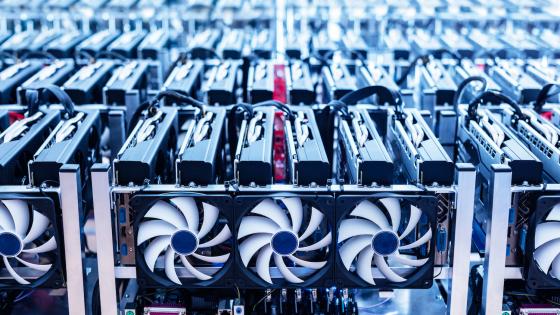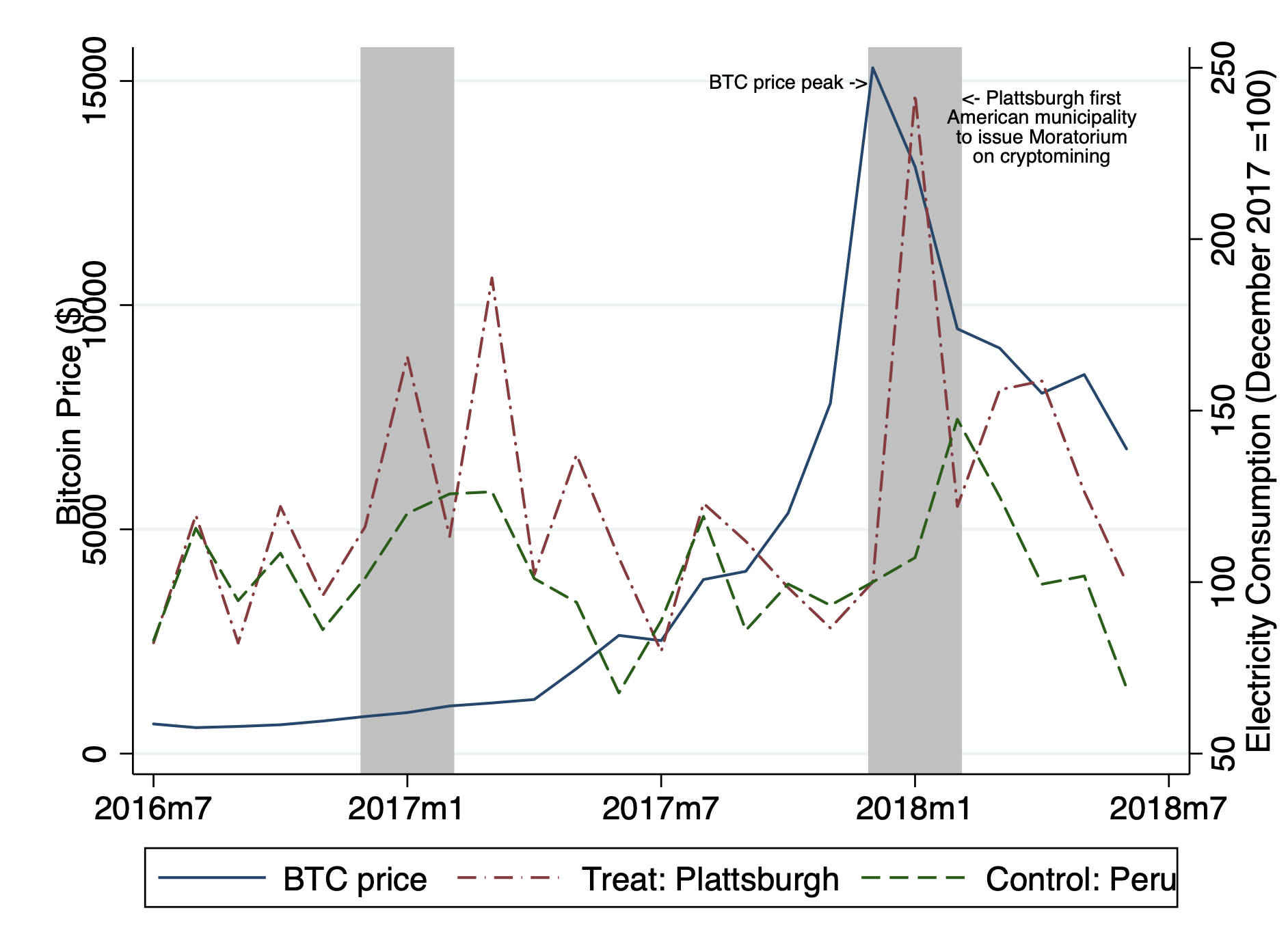High energy use is increasingly a feature of many technology processing industries, including quantum computing, artificial intelligence, natural language processing, and cryptocurrency mining (‘cryptomining’). Estimates suggest that technology processing passed the milestone of consuming 1% of world energy in 2010 and is on trajectory to increase to 6% by 2030 (Masanet et al. 2020, Andrae and Edler 2015). In recent years, data centres and Bitcoin mining alone consumed 0.9% and 0.5% of global electricity, respectively (Andrae 2017, Cambridge Center for Alternative Finance).
This intensive electricity consumption results in two negative externalities. The first is the carbon emissions resulting from electricity production of cryptomining, with the website Digiconomist estimating that the global CO2 emissions from Bitcoin mining alone are equivalent to those of Libya (see also De Vries 2018, Blandin et al. 2020).
Our work concerns a second, unstudied externality – the real effects of technology processing on local economies (Benetton et al. 2023). What, for example, are the spillovers from cryptomining on households and small businesses? How does the interaction of supply and demand impact prices and delivery of electricity to homes and small businesses? As we shall see below, cryptomining also has positive externalities in that cryptomines produce local tax revenues, raising questions about net costs and benefits.
Before describing our methodology and findings, a brief note about cryptomining, which is the clearing of payment transactions for decentralised blockchain-based cryptocurrencies that rely on the ‘proof-of-work’ protocol. Any person or firm can become a cryptominer, which involves solving increasingly complex computational puzzles to verify the validity of transactions. This has led to an arms race among firms who run large cryptomines, essentially warehouses full of specialized computers, crunching numbers across the world. And the key point here is that these cryptomines need lots of electricity, while employing very few people.
A tale of two channels
We analyse the negative externalities of the high electricity use of cryptomining through two channels: prices and quantity rationing.
Channel #1: Analysing negative externalities via prices
In the first case, we study New York State, specifically Upstate NY, excluding New York City and Long Island, which was an early market for cryptomining in the US due to its cold climate, cheap electricity, and proximity to large hydropower sources (see Figure 1).
Figure 1 Bitcoin prices and electricity consumption
Note: This Figure shows monthly electricity consumption for businesses in the town of Plattsburgh, NY, and the neighbouring town of Peru. Before the end of 2017, Plattsburgh and Peru experienced a similar pattern in electricity consumption for businesses. However, in January 2018, when the Bitcoin price peaked, electricity consumption by Plattsburgh businesses increased by almost 150%, whereas almost no change to the seasonal pattern occurred in Peru. The blue line shows the average price of Bitcoin each month. The red dash-dot line and the green dash line show total electricity consumption by small and industrial businesses in Plattsburgh and Peru, respectively. We normalise electricity consumption in each town to 100 in December 2017, which is the month in which Bitcoin prices reached their maximum of around $15,000. Gray areas denote December, January and February of 2016-2017 and 2017-2018.
The region’s grid operator employs a marginal supply pricing algorithm, whereby upward pressure on prices from demand gets passed to all users, including households and small businesses. We combine detailed data on these local electricity prices, electricity usage, and other economic outcomes with hand-collected data on the likely location of cryptominers, to analyse whether and how the use of electricity by cryptominers affects local communities.
Our findings include the following:
- When Bitcoin prices are high, the returns from cryptomining are higher in expectation since the reward to miners is paid in Bitcoins. Thus, a higher Bitcoin price increases the demand for electricity by cryptominers.
- There is a statistically significant, negative price elasticity of demand for electricity by the local communities, meaning that as the price of electricity rises, demand falls. These higher prices also lead to larger surpluses for electricity producers.
- There is a positive and significant effect of cryptomining on tax generation. Treated communities experience a relative increase in taxes per capita by $6 compared to control communities when the price of Bitcoin increases by 100%. To put these numbers in perspective, the price of Bitcoin increased from about $600 in 2016 to $7,500 in 2018, which could have led to higher taxes per capita in cryptomining communities by about $70, or 14% of the average tax revenue per capita.
- Cryptomining leads the average household and small business in New York to pay an extra $88 and $168 in their electricity bills per year, respectively. In aggregate, Upstate NY households and small businesses pay $204 million and $92 million more annually, respectively.
- When accounting for the differential increase in government revenues, cryptomining towns in Upstate NY generate almost $40 million in additional government revenues, thus recovering about 14% of the losses. As a result, we estimate a net consumer surplus loss of $257 million in Upstate NY.
Channel #2: Analysing negative externalities via quantity rationing
We now turn to China, a country that employed a quantity rationing system for electricity, and which hosted 65–82% of the world’s cryptomining during the last decade before a ban in 2021. In a quantity rationing system, when total demand increases, prices do not adjust; rather, the electricity supply is rationed among locations to align with physical infrastructure. To explore possible externalities associated with the rationing of electricity in local economies, we exploit an annual panel of statistics at the city level for China (cities in the data include the surrounding areas). We focus on the 218 inland China city-areas, which have a mean population of 355,000, and do not include the large coastal metropolitan areas. There is evidence of cryptomining in 52 of these inland city-areas, of which we find the following:
- After cryptomining enters a city, local fixed asset investments decline annually by 19%, and wage levels decline by 10%, suggesting that cryptomining tends to crowd out other business uses of electricity.
- These results also suggest that the crowded-out industrial uses of electricity would have led to larger investments in the physical and human capital of the local economy in the years following the entry of cryptomining. To put a number on it, cryptomining entry is associated with a statistically significant drop in local GDP of 8.2%.
- Taken together, these findings suggest that local economies could suffer as a result of crowding out in the electricity market.
Conclusion
We present novel empirical evidence of the real effects of cryptomining on local economies.
First, we focus on a setting in Upstate New York, where cryptomining led to an increase in electricity prices and a resultant consumer surplus loss. On the other hand, local governments saw an increase in tax revenues, although this only offsets a fraction of the consumer surplus loss through higher electricity prices. We then turn to China, where we reveal a negative impact on the labor market as well as fixed asset investments.
What does this mean for policymakers? Though likely tempting for some, the optimal response is likely not to ban cryptomining, which would only shift the problem to a more permissive jurisdiction and restrict any possible tax revenue gains. Rather, a better response would be to introduce electricity pricing schemes or dynamic quotas that minimise the adverse impact on the local community. In addition, the effects on local communities we document should be weighed against any other costs (notably, from pollution) and potential benefits arising from the growth of proof-of-work cryptocurrencies.
References
Andrae, A (2017), “Total consumer power consumption forecast”, Nordic Digital Business Summit 10.
Andrae, A S G and T Edler (2015), “On Global Electricity Usage of Communication Technology: Trends to 2030”, Challenges 6(1): 117-157.
Benetton, M, G Compiani and A Morse (2023), “When Cryptomining Comes to Town: High Electricity-use Spillovers to the Local Economy”, NBER Working Paper 31312.
Blandin, A, G Pieters, Y Wu, T Eisermann, A Dek, S Taylor and D Njoki (2020), “Third global cryptoasset benchmarking study”, Technical report, Cambridge Centre for Alternative Finance, University of Cambridge, Judge Business School.
De Vries, A (2018), “Bitcoin's growing energy problem”, Joule 2(5): 801-805.
Masanet, E, A Shehabi, N Lei, S Smith, and J Koomey (2020), “Recalibrating global data center energy-use estimates”, Science 367(6481): 984-986.






